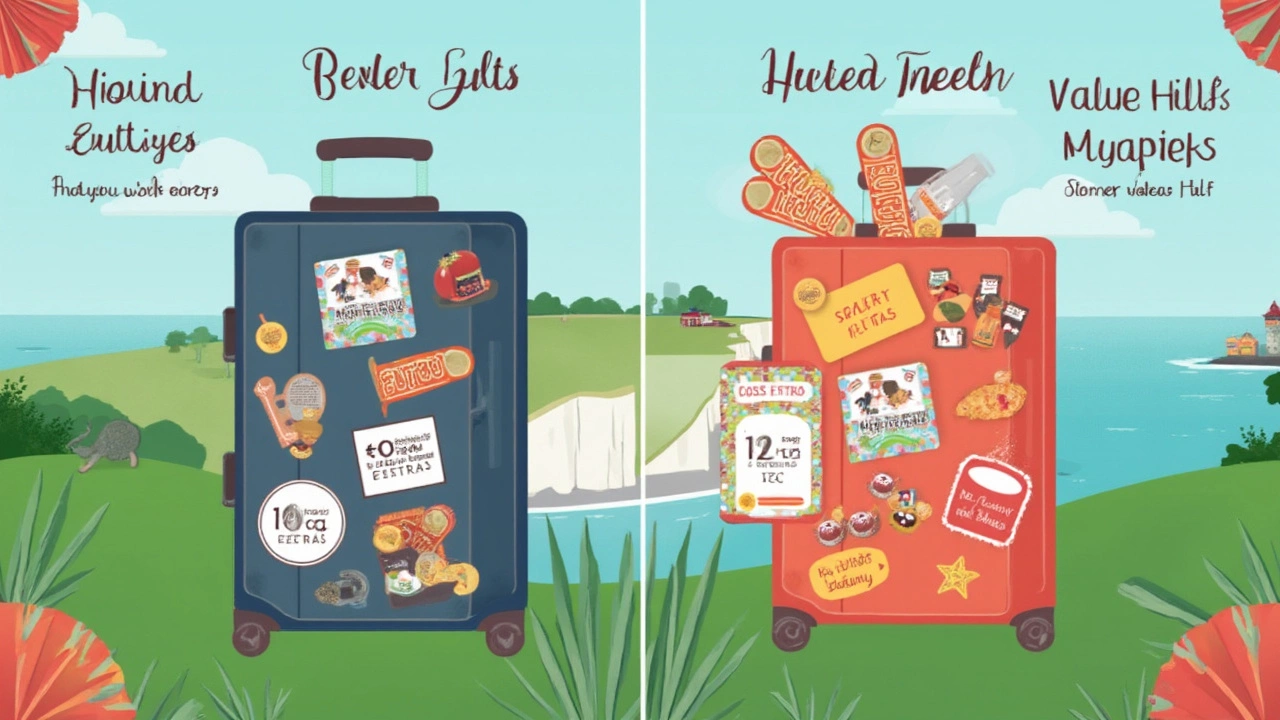All-Inclusive Resort: Is It Worth It?
4 May, 2025Picture this: You stroll from the pool straight to a buffet, order another round of drinks, and—best part—no bill shows up. That’s the hook with all-inclusive resorts. You pay once, and supposedly, everything’s covered. But is it really the smart move for your next getaway?
All-inclusives sound like a dream, especially if you hate pulling out your wallet every time you want a snack or cocktail. But there are a few catches and surprises people don’t talk about upfront. If you’re dreaming of endless lobster, premium drinks, and five-star activities—pause for a second. Not every “all-inclusive” delivers the same deal.
- What Does 'All-Inclusive' Really Mean?
- Breaking Down the Costs
- Perks and Drawbacks You Didn’t Expect
- Who Should Go All-Inclusive (And Who Shouldn’t)
- Tips to Get the Best Value
What Does 'All-Inclusive' Really Mean?
All-inclusive resorts love to promise the world, but what do you actually get? At most all-inclusive spots, your room, meals, basic drinks, and a handful of activities are part of the deal. You usually see three main meals daily, snacks, non-alcoholic drinks, and house-brand alcohol bundled in that final price. But heads up—"all" doesn’t always mean everything under the sun.
There’s a good chance some things cost extra, like fancy cocktails, top-shelf spirits, spa treatments, or certain water sports. Want to order room service after midnight or eat at the fancy steakhouse on site? You might find a surprise bill waiting. Kids’ clubs and basic group games are usually included, while golf or scuba often isn’t.
Here’s a quick look at what’s typically included and what’s often not:
- Included: Your hotel room, buffet meals, most snacks, house wine and beer, group activities like yoga classes, and access to pools and basic non-motorized water sports (think kayaks, paddle boards).
- Not Included: A la carte restaurants, room service after certain hours, high-end alcohol brands, spa sessions, off-site tours, and tips (sometimes).
Hotel contracts can get tricky, especially with resort chains that use similar wording but mean different things. Some brands like Club Med or Sandals come closer to truly all-in: more specialty restaurants and water sports, even airport shuttles tossed in. Budget chains might hand out wristbands and then tack on hidden charges left and right.
| Included | Usually Extra |
|---|---|
| Buffet Meals | Fine Dining Restaurants |
| House Alcohol | Top-Shelf Drinks |
| Non-motorized Kayaks | Jet Ski Rentals |
| Standard Room | Oceanfront Upgrade |
Always read the fine print before booking. Some resorts add things like "resort fees" at check-in, which can kill the upfront savings. If you’re the type to hang around the buffet and swim-up bar all day, most "all-inclusive" resorts fit the bill. But if you crave more, you’ll want to dig into what’s actually bundled in before you swipe that card.
Breaking Down the Costs
Let’s get real about what you actually pay for at an all-inclusive resort. That sticker price covers your room, meals, and a lot of drinks and activities. But it’s not always as all-in as you’d think. A week for two people can run anywhere from $1,800 to over $5,000 depending on location, season, and how fancy you want to go. And get this: a 2023 survey by Travel Market Report found the average Caribbean all-inclusive costs about $2,400 per couple for a week.
So, what’s included? The basics:
- Accommodation—your hotel room, often with a nice view
- Buffet and some specialty restaurant meals
- Unlimited local drinks, often including alcohol
- Most onsite activities—think pool games, kayaking, fitness classes
But here’s the catch: premium stuff is usually extra. Top-shelf liquor, spa treatments, fancy dinners (like lobster night), and excursions off the resort almost never make the cut. You’ll want to check the small print before you book so you don’t get hit with surprise charges.
"All-inclusive doesn't always mean everything is included. Resorts differ—always check what's actually covered before you get there." — Lonely Planet Guide, 2023
Another thing that can trip people up is tipping. Some resorts include gratuities, but at others it's expected and can add up fast right at the end of your stay.
If you like data, here’s how a typical cost breakdown looks for a one-week stay for a couple at a mid-range all-inclusive in Cancun:
| Item | Estimated Cost (USD) |
|---|---|
| Room & Meals | $1,500 |
| Drinks (included) | $0 |
| Excursions | $300 |
| Spa Treatments | $200 |
| Tipping | $100 |
| Total | $2,100 |
The bottom line? Add up all the extras you care about before booking. Sometimes a “cheap” all-inclusive turns pricey if you go off-menu. But if you like knowing what you’ll spend upfront and don’t plan to leave the property much, this setup can save you some real cash—and headaches.

Perks and Drawbacks You Didn’t Expect
Let’s get real about what you might actually run into at a all-inclusive resort. On paper, it’s all sun, food, and fun. But there are surprises—good and bad—that you might not see coming until you’re already unpacked.
First, the perks. The main pull of all-inclusive resorts is obviously the unlimited food and drinks. You can grab snacks and cocktails anytime without checking the price tag, and if you’re traveling with family, the savings add up fast. Some spots even throw in extras like water sports, gym access, kids’ clubs, and live shows. No extra charges means you can relax instead of nickel-and-diming your way through vacation. One fun fact: at several Caribbean all-inclusive resorts, guests average more than 20 drinks per day—so if you like your daiquiris, the math can work in your favor.
But there are some not-so-great surprises, too. For starters, not everything at these hotel packages is always included—even if the booking page says "everything." Fine print catches a lot of folks off guard. Lobster night, specialty dining, spa treatments, top-shelf booze, or motorized water sports might come with hefty extra fees. Hotels slap on wristbands and can get pretty strict about what “included” really covers. Want a fancy dinner or a premium room? Sometimes, it’s not part of the package.
- Buffet food can get repetitive—think pasta, potatoes, and more potatoes.
- Some premium drinks aren’t included, even at high-end all-inclusive hotels.
- Activities and off-site excursions can cost extra, sometimes at tourist-trap prices.
- Wi-Fi isn’t always free or fast—double check before you count on streaming Netflix.
Crowds are another thing. Resorts can book up fast, especially during peak seasons, and that means long buffet lines, packed pools, and waiting for activities. If you’re dreaming of peace and quiet, it’s hit or miss based on the spot you choose.
| What’s Usually Included | What Might Cost Extra |
|---|---|
| Main buffets, snacks, house alcohol, basic activities, kids’ club | Spa services, excursions, some restaurants, premium alcohol, room upgrades |
The bottom line? All-inclusive vacations are great if you want a chill, wallet-free week with no surprises—just remember to read the fine print and ask what’s actually included before booking.
Who Should Go All-Inclusive (And Who Shouldn’t)
Here’s where the all-inclusive magic really works—and where it can fall flat. Not everyone gets the same value from these resorts. Knowing if you’re in the right crowd can save you cash and headaches.
If your idea of a perfect vacation is parking yourself poolside with a bottomless frozen drink, you’ll love it. Families with kids? Game-changer. Some of these spots have full-on kids’ clubs, splash parks, and non-stop snacks—so parents actually get to relax. Groups celebrating special occasions (like birthdays, reunions, or bachelor parties) can also get the most bang for their buck since food and drinks are already paid for, and there’s no fighting over bills.
Here’s a quick breakdown of who really wins with the all-inclusive setup:
- Families who want stress-free logistics—meals, kid activities, and entertainment bundled into one price
- Travelers who eat and drink more than average—endless buffets and open bars only make sense if you actually use them
- First-timers who feel nervous about travel—everything’s on-site, safe, and easy to navigate
- Groups who don’t want to split bills or fuss over where to eat every night
- Travelers visiting countries where language or travel safety is a concern—sticking to resort activities keeps things straightforward
But all-inclusive resorts aren’t for everyone. If you’re the type who wants to be out exploring local towns, trying street food, or diving into hidden restaurants, you’ll probably feel boxed in. Most packages don’t include off-site adventures or authentic local eats. Sometimes you pay for way more food or booze than you’ll actually use. Light eaters and folks who prefer unique, à la carte meals over buffets usually find the experience disappointing.
Couples and solo travelers, especially the adventurous or food-obsessed, might find better value picking a cool boutique hotel or Airbnb and choosing where to eat and what to do. Here’s a quick look at the flip side:
- Budget travelers who want flexibility and don’t plan to be at the hotel all day
- People eager to eat and shop in town rather than at a hotel buffet
- Anyone who sees vacation as nonstop exploring—not just lounging
- Folks with strict dietary needs—sometimes buffets and set menus aren’t enough
If you’re still on the fence, think about how you usually travel. If you love routine and easy access to amenities, all-inclusive resorts might check every box. If you get restless staying in one spot, or you want every meal to be a new adventure, it’s probably not your scene.
| Best for | Not great for |
|---|---|
| Families, groups, heavy eaters/drinkers, first-timers | Adventurers, light eaters, culture hounds, foodies |

Tips to Get the Best Value
Before you book any all-inclusive resort, dig into what's really on the table. Not all resorts toss in the same perks—some charge extra for decent Wi-Fi, specialty restaurants, or even bottled water. Here’s how to come out ahead.
- Compare what’s actually included. A resort might say “all meals,” but only at the buffet—not the steakhouse. Check the fine print about alcohol, room service, and on-site activities.
- Look out for sneaky extras. Spa treatments, golf, and excursions are usually not part of the package. Even airport transfers can sometimes cost extra, especially at budget hotel packages.
- Travel during the shoulder season. You’ll save a chunk of change skipping peak holiday weeks, and the resort won’t feel like a packed cafeteria. Early May or late September usually means better rates and smaller crowds.
- Check the reviews for food and service. People often complain about food quality or ridiculous wait times at certain “included” restaurants. Finding a resort with good reviews for both is a must.
- Don’t pay for upgrades you won’t use. Some packages push room upgrades, but if you’re always out and about, a base-level room is fine. Save that cash for something you’ll actually enjoy elsewhere.
| Included? | Usually Free | Often Costs Extra |
|---|---|---|
| Food | Main buffet, snacks | Specialty restaurants |
| Drinks | House wine, local beer | Premium liquor, fancy cocktails |
| Activities | Pool, gym, some classes | Spa, golf, excursions |
| Transfers | Varies by resort | Common extra fee |
One tip that works? Call or email the hotel directly before you book. Ask for a detailed list of what’s included. You might even stumble into a promo rate, free upgrades, or resort credits. Sometimes loyalty programs can shave a little more off the price or throw in extra perks—not everyone mentions this online, so it pays to ask directly.
With these small moves, you’re less likely to get burned and more likely to enjoy every part of your all-inclusive vacation—without blowing your budget.

 by
by